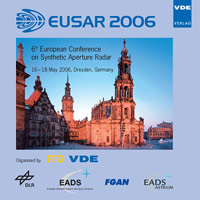PIRDIS: A New Versatile Tool for SAR/MTI Systems Simulation
Konferenz: EUSAR 2006 - 6th European Conference on Synthetic Aperture Radar
16.05.2006 - 18.05.2006 in Dresden, Germany
Tagungsband: EUSAR 2006
Seiten: 4Sprache: EnglischTyp: PDF
Persönliche VDE-Mitglieder erhalten auf diesen Artikel 10% Rabatt
Autoren:
Meyer-Hilberg, Jochen (EADS Deutschland GmbH, Defence Electronics, mmW Sensor Systems, Ulm, Germany)
Inhalt:
Development and testing of Synthetic Aperture Radar (SAR) systems is a cost and time consuming process, because on the one hand, complex hardware for transmitter, antenna, receiver and SAR image processing is required, and on the other hand, flight trials using aircraft or satellites are expensive and dependent on weather and availability of platforms. In this respect, it is highly desirable to get samples of the SAR system performance with low cost already during the design phase of the SAR system for concept verification and performance assessment purposes. The solution for this problem is a comprehensive simulation program using models for all relevant system parts. Additionally, SAR simulation allows the exact repetition of flight trajectories for statistical analysis especially for missile applications. A new simulation program called “PIRDIS” (Platform-Independent Range/Doppler Image Simulation) is optimally suitable for these purposes. In this paper, model requirements, concept, simulation models and validation of PIRDIS will be discussed. PIRDIS is based on three main parts: firstly, landscape is modelled using height and feature data, secondly, man-made objects are modelled using CAD models, and finally, the SAR system is simulated using models for all sensor components. SAR relevant effects such as speckle, side lobes, blurring due to limited Inertial Measurement Unit (IMU) quality as well as losses due to atmosphere and rain are simulated in a realistic way. Moreover, any SAR geometry can be chosen, i. e. standard side-looking geometry, forward-looking geometry or any squint angle in between. Also, multi-channel antennas as well as bistatic configurations can be simulated e. g. for Moving Target Indication (MTI) applications. Finally, the Graphical User Interface (GUI) of PIRDIS will be presented, showing, that typical simulation runs are finished within some seconds.


